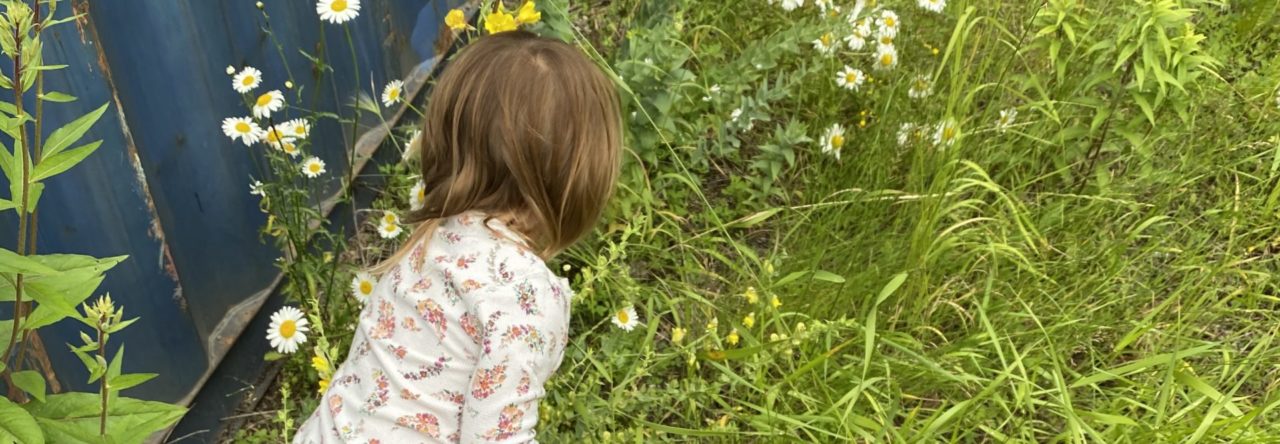Part 1: Course Activities
Course Learning Outcomes:
- Develop an awareness of the potential of human-centered learning in online and open learning contexts
- Explore and engage with current literature on the distributed and open education movement
- Critically reflect on and articulate concepts around modality, pedagogy, and access, includingdistributed and open learning theory, online and open learning history, privacy laws, online learning communities, open research, and open data.
- Examine and reflect upon the potential for equitable access for all learners in online and openlearning contexts.
- Conduct research into and critically reflect upon emerging and future educational technologies
- Practice digital, networked, and open literacies in support of learning about distributed and openlearning.
(Evidence and description of learning will show connections to the course outcomes through bracketed numbers (ex. (5)).
Week 1: Build a PLN/Social Media
Link to Blog Post: Week 1: Build a PLN/Social Media ePortfolio Blog Post
As I began to build a new online presence and explore a new form of networking, I was able to practice and gain further understanding of how beneficial open digital networking can be as I observed and participated in the sharing of ideas and resources amongst the education world (6). (Link to my Twitter profile: Profile)
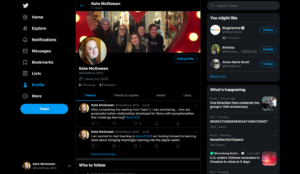
Week 2: Open Learning (Padlet)
Link to Blog Post: Week 2:Open Learning (Padlet) ePortfolio Blog Post
This application allowed me to explore and engage in a new digital networking tool (6). It further promotes the importance of social interaction throughout learning as resources, questions, and advice are openly shared. I found that this application allows for human-centred learning where students are able to pose and answer questions regarding their own interests and foster their academic understanding (1).
Link to Padlet page: https://padlet.com/verenanz/5na
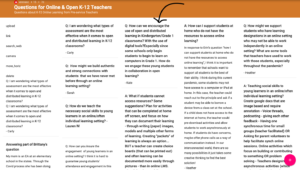
Week 3: Create Activity
Link to Blog Post: Week 3: Create Activity ePortfolio Blog Post
As I made this video, I kept thinking about how animation could be used as a tool to provide multiple means of engagement, representation, and action and expression throughout learning. This would give students equitable access to enjoying learning, explore new materials and demonstrate their learning (4). I was also able to explore new digital technologies that could be used by students or educators to demonstrate learning or deliver information creatively (6).
Link to my Instructional Animation Video:
Universal Design for Learning.mp4
Video Resources:
CAST (2018). Universal Design for Learning Guidelines version 2.2. Retrieved from http://udlguidelines.cast.org

Week 4: Topic 2 Webinar
Link to Blog Post: Week 4: Webinar (Topic 2) – ePortfolio Blog Post
This activity gave us the opportunity to hear more about the perspectives, guidelines and resources available regarding open, online, and remote pedagogy from published professionals. This allowed me to develop a better understanding of these concepts (2) and allowed me to look further into the history and development of online learning as well as the differences between the theories and principles behind online, open, and remote learning (3).
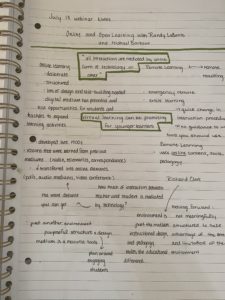
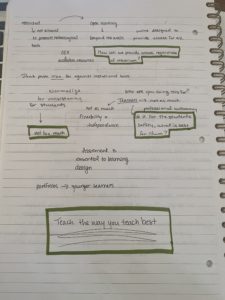
Part 2: Updated Blog Post
Original Blog Post Link: Topic 2 Blog Post
Take a look at my mind map to see my updating plan! How will I update my Blog Post?
How would you describe the historical and theoretical trends in k-12 online and distributed learning? What did you already know, what do you know now based on the course readings and activities, what do you hope to learn?
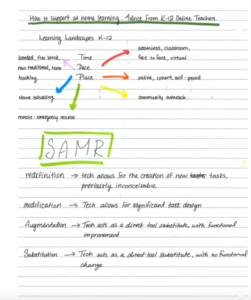
Before this topic, I was unaware of how far back the use of online and distributed learning went especially in Canada. It was interesting to read about the inner workings of distributed and online learning in Canada and how it varies across the country as well as how learning theories and definitions of open, distributed, online, and e-learning have developed and changed over the years.
Learning Theories:
Learning Theories Google Slides Link: Learning Theories
Definitions
Open Education Practices:
Practices which “support the productions, and reuse of high quality open educational resources (OER) through institutional policies, which promote innovative pedagogical models, and respect and empower learners as co-producers on their lifelong learning path (Roberts et Al., p. 528)”.
- Initially introduced to remove the barriers of a closed environment and open up learning
- Now includes Open Software, data, and learning.
- Supported by:
- Dewey (1916) – learning from and with each other
- Vygotsky (1978) – learning is shaped by sociocultural factors
- Paquette (2005) – based on individual differences and growth, developmentally appropriate learning outcomes (Roberts et Al., 2018).
Open Learning:
8 principles
- learner-centeredness
- lifelong learning
- flexibility in learning
- removal of barriers to access
- recognition of prior learning experiences and current competencies
- learner support
- expectations of success
- cost effectiveness (Roberts et Al., 2018, p.529)
Blended Learning:
- Part through online learning, some element of student control over time, place, path, and/or pace
- Part in traditional school setting
- Modalities in each learning journey within subjects are connected to provide an integrated learning experience (Roberts et Al., 2018, p.539).
E-Learning/Online Learning
- “The implementation of computer technologies to education. E-learning can take many forms, whether it is used face to face in classrooms, as a share of required classroom activities or stroke work (e.g. online discussions), or to deliver a fully online course. E-learning can include distance education as well as traditional in-class instruction (Barbour and LaBonte, 2018, p. 601) “
Remote Access / Emergency Learning
- Crisis learning
- Quick change in instructional procedures
- No guidance to what tools you should use
- Uses online content, tools, sometimes pedagogy
- Not as structured as online learning (LaBonte and Barbour Webinar, 2020)
“What type of learning setting [do] you think you would be the most successful in: open learning, blended learning, online learning or face to face? What skills do you possess that would make you successful in one setting over another (Heemskerk, 2020)”?
I think I would be most successful learning in a blended learning environment. As blended learning environments aim to offer the best of both worlds for online and traditional learning, this provides students with ample opportunities to explore new tools, resources, interests, and material. It also allows learning to be a mix of synchronous and asynchronous learning which I find works thes best for me. I find that i am able to accomplish more when i am able to discuss and review new concepts in a traditional classroom environment synchronously with an instructor and classmates who can help shine a light on new concepts and later on explore a topic myself asynchronously and spend time diving deeper on my own and demonstrating my knowledge. I am able to work well in groups but I am able to get more done on my own; however I do need help understanding the depth of some concepts. This is where it helps to have blended opportunities. If I had to do just one (online or traditional) I don’t think I would be able to be as successful as I could be. In online, there isn’t as much communication and social interaction to help understand concepts (however, there are growing opportunities for this) and in traditional there is not as much work on your own in your own way time.
History
Canada:
- Education varies across the country, ministries develop curriculum to respect the uniqueness of each province
- Distance Education used for almost 100 years, one of the first countries to use the internet to deliver distance education
- B.C. began using distance education. in 1919 and virtual schools in 1993
- Online and blended programs vary from traditional distance education models, to all online or a blended model
- One of the highest per capita student enrollment in e-learning programs
- Most programs in Canada use a blended learning format, asynchronous online format, or video conferencing (Barbour and LaBonte, 2018).
British Columbia:
- 59 district distributed learning schools
- 16 private distributed learning schools
- The ministry of Education manages a list of all courses offered by distributed learning schools and provides content and online hosting services (Barbour and LaBonte, 2018).
Growth and Development of Online and Open Learning since the onset of COVID -19:
Q: How has online learning worked for younger students? How effective has it been? Positive effects? Negative Effects?
Answers from Current Teachers: Teacher Responses
Moving On:
- I am interested to look further into the effect of social interaction on student growth, development, and learning. How can we promote this with younger students?
- How can we promote the use of a blended learning system with younger students and those with exceptionalities?
- How can we encourage collaboration through online mediums with our exceptional students and our primary students?
- To what scale do each of the learning theories fit with distributed and open learning? What about multimedia learning theories?
Further Resources:
- Anderson, T., McGreal, R. (2007). E-Learning in Canada. International Journal of Distance Education Technologies, Volume 5, Issue 1. Edited by Shi-Kuo Chang; Timothy K. Shih. Retrieved from: https://auspace.athabascau.ca/bitstream/handle/2149/744/e-learning_in_canada.pdf?sequence=1&isAllow ed=y
- Lee, T. (Feb 25, 2016). Learning Theories. [Youtube]. Retrieved from: https://www.youtube.com/watch?v=B2bsyT2S82I
- Powell, K.C., Kalina, C.J., (n.d.). Cognitive and Social Constructivism: Developing Tools for an Effective Classroom. Florida Atlantic University. Education Vol. 130 No. 2, p.241-249. Received from: https://docdrop.org/static/drop-pdf/Powell-and-Kalina-U6g4p.pdf
- Sochaki, C. (June 5, 2017). Vygotsky’s Social Interaction. [Youtube]. Retrieved from: https://www.youtube.com/watch?v=zAcNO14HnEE
References:
Barbour, M & Labonte, R. (2018) An Overview of eLearning Organizations and Practices in Canada. In R. Ferdig & K. Kennedy (Eds.), Handbook of research on K-12 online and blended learning (pp. 600-616). Pittsburgh, PA: Carnegie Mellon University ETC Press.
Barbour, M & Labonte, R. (July 14, 2020) Open and Online Learning in a K-12 Context. Topic 2 Webinar Retrieved from: https://edtechuvic.ca/vroberts/2020/07/14/topic-2-online-open-learning-webinar-with-dr-randy-labonte-dr -michael-barbour/
Bates, T.(2014). Learning Theories and Online Learning. [Blog post]. Retrieved from https://www.tonybates.ca/2014/07/29/learning-theories -and-online-learning/.
Doyle, Nadine (July 22, 2020). Interview.
Garrett Dickers, A. (2018) Social Interaction in K-12 Online Learning. In R. Ferdig & K. Kennedy (Eds.), Handbook of research on K-12 online and blended learning (pp. 509-522 ). Pittsburgh, PA: Carnegie Mellon University ETC Press.
Heemskerk, C. (July 14, 2020). Topic 2 Blog Reply. Carly’s Corner. Retrieved from:https://carlyheemskerk.opened.ca/category/distributed-and-open-learning/
Helfrich, Kristen (July 22, 2020). Interview
Roberts, V. , Blomgren, C. Ishmael, K. & Graham, L. (2018) Open Educational Practices in K-12 Online and Blended Learning Environments. In R. Ferdig & K. Kennedy (Eds.), Handbook of research on K-12 online and blended learning (pp. 527–544). Pittsburgh, PA: Carnegie Mellon University ETC Press.
